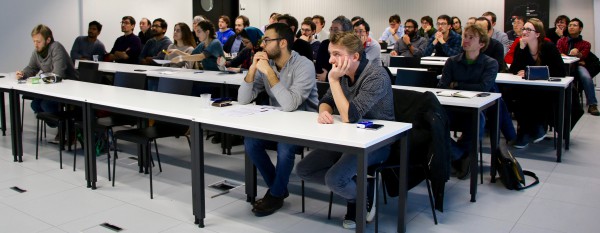MARVEL Junior Seminar — May 2021
Zoom meeting link:
https://epfl.zoom.us/j/93881551248
Password: 3417
The MARVEL Junior Seminars aim to intensify interactions between the MARVEL Junior scientists belonging to different research groups.
Each seminar consists of two presentations of 25 minutes each, allowing to present on a scientific question in depth, followed by time for discussion. The discussion is facilitated and timed by the chair.

MARVEL Junior Seminar Organizing Committee — Michele Kotiuga, Sara Fiore, Stefano Falletta, Kristians Cernevics, Max Veit and Patrick Mayor
Talk 1 — Finger prints based biasing for finding complex reaction pathways
Deb Sankar De, Marco Krummenacher, Bastian Schaefer, and Stefan Goedecker
Department of Physics, University of Basel
Determining the pathway of a reaction/transformation is of great importance in chemistry, physics and materials sciences. However, due to the indistinguishability of atoms, finding complex reaction and transformation pathways, containing a large number of intermediate states, is difficult within the existing methods at the density functional theory level.
We have resolved this issue by introducing a bias that is invariant under atomic index permutations and that can target a single well defined configuration as the final configuration of a chemical reaction or physical transformation. In this way we can overcome the index mapping problem. The forces arising from the bias, by construction, do not depend on the indexing of the atoms. We have thus reduced the combinatorial atomic indexing problem, that has an exponential scaling, to a global minimization problem on a biased PES involving an indexing invariant penalty function. The later problem can be solved easily in practice. The penalty function we propose is universal and can be applied to any reaction or transformation. Using this method we will explore the PES of different systems i.e. C60, Si20H20 etc.
Talk 2 — Tuneable luminescence from biomolecule-inspired single-species emitters of white light
Fatmah Mish Ebrahim1, Maria Fumanal1,4, Andrzej Gładysiak1, Özge Kadioglu1, Kevin Maik Jablonka1, Daniele Ongari1, Amber Mace1, Serhii Shyshkanov1,2, Seryio Saris3, Christopher Patrick Ireland1, Paul J. Dyson2, Kyriakos C. Stylianou1 and Berend Smit1
1 Laboratory of Molecular Simulation (LSMO), EPFL, Sion
2 Laboratory of Organometallic and Medicinal Chemistry (LCOM), EPFL
3 Laboratory of Nanochemistry of Energy (LNCE), EPFL, Sion
4 IBM Research Zurich, Rüschlikon
Single-species light emitters with high photoluminescence quantum yields (PLQYs) and broad-spectrum color tunability are sought-after for applications ranging from bio-imaging to artificial lighting. We explore a new strategy to design such emitters, inspired by bioluminescent fireflies and click-beetles. These organisms use a single molecular substrate, D-Luciferin (LH2), to emit light ranging in colour from green to red. By combining LH2 with metals, we synthesise new bio-analogous, colour-tunable, luminescent metal complexes. The copper complex forms an organic molecule of intrinsic
23 microporosity (OMIM), which crystallises into a stable structure with intermolecular voids. By changing the composition of guest molecules in the voids, we can tune the emitted colour. The optimum composition gives nearly perfect white light, with the highest PLQY reported for a single-species white-light emitter. Similarities between our OMIM and the luciferase active site provide a new approach to investigate the heavily-debated mechanisms underlying in-vivo bioluminescence colour variations. Moreover, as a proof of principle, we show that these materials can be used in a new type of light-emitting device (LED). The current generation of LEDs requires at least two active layers to achieve colour tunability. The tunability is intrinsic in our materials, and therefore may lead to simpler device fabrication.
Check the list of the next MARVEL Junior Seminars here.
Low-volume newsletters, targeted to the scientific and industrial communities.
Subscribe to our newsletter